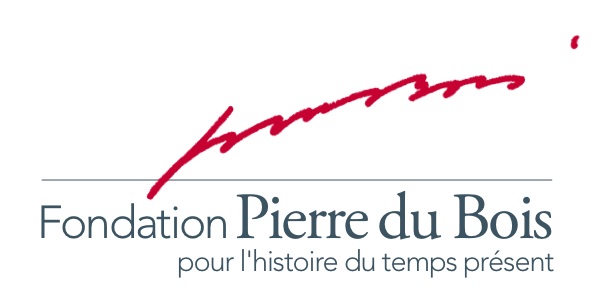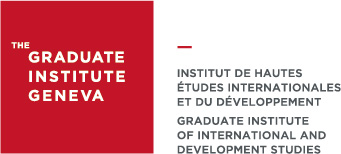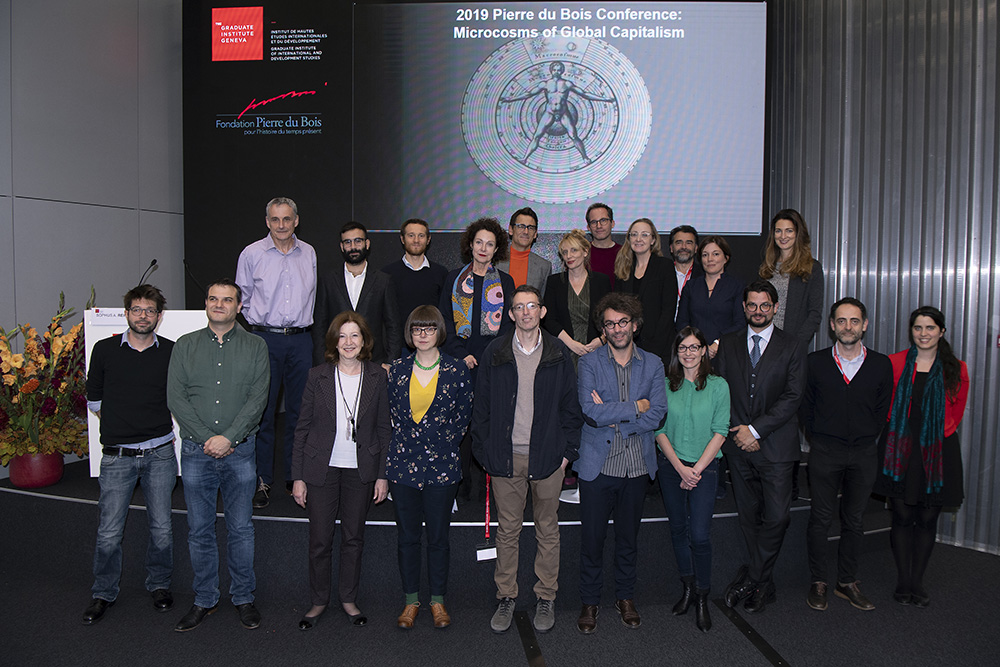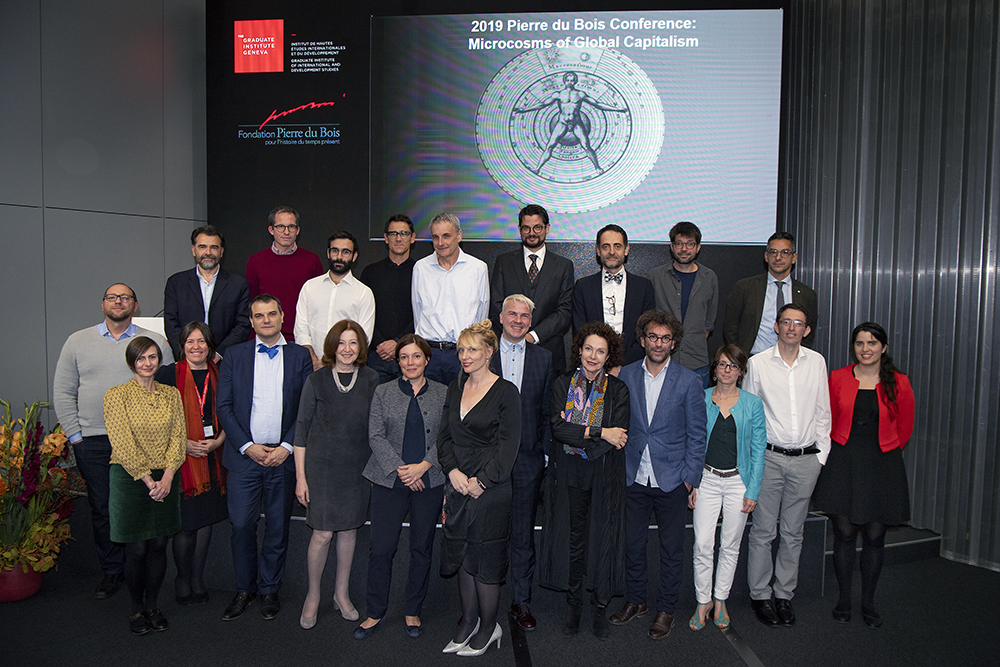MICROCOSMS OF GLOBAL CAPITALISM
03 – 04 October 2019
The 2019 Annual Pierre du Bois Conference, organized by the Graduate Institute in partnership with the Pierre du Bois Foundation, took place at Maison de la Paix from 03 – 04 October 2019. Professors Carolyn Biltoft and Amalia Ribi Forclaz organized the conference.
Julia Ott Professor of History at the New School in New York gave the Keynote Lecture titled From the Jim Crow South to Global Neoliberalism. More information about the Keynote can be found here.
Here are links to the biographies of all speakers that participated, the program, the background note, and the photo gallery. A detailed summary of the conference follows the images.
Recent theories of global capitalism have described an inherent contradiction; on the one hand, through the mechanisms of exchange, the world has become increasingly welded into an economic system, with every region of the world constituting a different “part” within the whole. At the same time, that purported economic unity grew alongside growing gaps between a global rich and a global poor. Rather than taking a traditional and descriptive tack to this state of affairs, Microcosms of Global Capitalism, set out to view and assess the holistic dynamics of global capitalism by gazing at a number of microcosms or “fragments.” Stretching from the birth of companies in the ancient world to the modern growth of wine industries, each panel sought to “see” something of the world itself in the granular perspective of a single place, time or object.
The two-day conference began with an introductory lecture by Carolyn Biltoft that explored tropes of scales and scope. Beginning with an exploration of a range of literary works that relied on scale and size alterations as devices (such as Jonathan Swift’s Gulliver’s Travels, Voltaire’s Micromegas, and Lewis Carole’s Alice in Wonderland) the lecture then suggested that we might think in more transversal ways about the division in both history and economics between “micro” and “macro.” Biltoft suggested that such divisions reveal the ways in which modern disciplines or fields of knowledge have retained deep metaphysical concerns not only with the tiny and the gigantic, but also with the relationship between the “part” and the “whole.” The lecture ended by inviting the participants to consider what the choice of “scale” might reveal about the broader dynamics of the global economic system.
After the introductory lecture the first panel entitled, “The Human Heart: Capitalism and Its Emotional Registers,” tried to discern the dynamics of what Martijin Konig has called The Emotional Logic of Capitalism. In this panel, Ilaria Scaglia and Julie-Marie Strange each reflected on the moral aspects of capitalism. Scaglia looked at the representation of labour as therapy and the work carried out by recovering patients at the Clinique Manufacture Internationale in Leysin. Strange explored the material and social dynamics of charitable giving through the history of the Salvation Army. Both examples showed how efforts to identify and address the problems of capitalism ultimately lead to reproducing them.
Panel two, “Market-Scapes: Money, Taxes, and Investments,” investigated the key elements of money, taxes and investments. Mathieu Leimgruber showed how a small number of tax lawyers worked in a close network and successfully lobbied to be included in all international tax negotiations of the 20th century. In other words, a small cadre of experts came to determine the course of global tax policy. Continuing on the power of interpersonal networks and expertise, Kim Oosterlinck presented a paper that explained how two Jewish art experts survived WWII by making themselves essential to influential art dealers of the Reich and thus traded forms of protection against market expertise. Maylis Avaro demonstrated how international diplomacy can also be shaped by market dynamics; studying the case of postwar sterling area, she highlighted that the difficulties of sterling in international money markets influenced heavily British imperial policies in the Commonwealth. Collectively this panel showed the deep embrocation between politics and economic markets.
Panel three, “The Company: On Profit and Its Pursuits,” was united around the microcosm of the “company.” Fabio Lopez Lazaro opened the panel by looking at the contours of the medieval corporation, to look at the grand concept of “perpetuity,” both in terms of the financial continuation of corporations and the fragile and euro-centric distribution of archival records despite the inherently global nature of especially early modern trading companies. Pilar Nogues-Marco, took up the Marxist critique of the British East India Company and put it to the economic historians’ test. She argued that indeed, in the murky interstices between “company” and “empire,” the profits of the early modern joint stock company derived from extractive and exploitive practices in India. Finally, Lola Wilhelm explored the links between economic interests, scientific research and public policy through the microcosm of Nestlé’s laboratory for the development of powdered infant-milk in interwar Switzerland, adding a further layer to our understanding of the corporation’s social as well as economic and scientific role in the development of capitalism.
Panel four, “ The Grid: On Currents and Capital Flows,” took up the theme of infrastructure and its role in past and present capitalist development. By looking at the wind farms in Southern Mexico, Dominic Boyer revealed the political conflicts and competing aspirations at the heart of local/global energy nexuses. In revisiting the fraught terrain implicit in the idea of “ownership” of natural resources, Boyer offered an opportunity to rethink the lives and life-worlds at stake in capitalism’s relationship to its energy sources. Moving along the grid backward in time, José Antonio Sanchez Roman looked at the economic and political interests that passed through the League of Nations Communications and Transit Section after WWI. Focusing on the international interests circling the “grids” being built and rebuilt after the chaos of a global war, Sanchez Romain revealed the extent to which infrastructures constituted the beating heart of efforts to fund, own and control the international system.
At the end of the day on Thursday, Julia Ott of The New School, New York City, delivered her keynote address, From the Jim Crow South to Global Neoliberalism. As her chosen microcosm, Ott took up the machinations of a group of U.S Southern Democratic Senators who controlled the Senate Finance Committee from 1936 to 1965. That small group of figures was able to wield an outsized influence on capital gains tax policy, which not only retrenched privileged forms of tax relief for the very wealthiest members of American society, but also re-inscribed race-based forms of financial exclusion. Through this lens, Ott was able to show in miniature and in one region of the world, the broader dynamics driving the neo-liberal policies of both local and global inequality.
Friday morning opened with panel five, “The Seed and its Multiplications.” Carl Wennerlind opened the panel by exploring the ways in which as early modern Swedish “political economists” probed the many uses of the spruce cone they also posited a world of endless growth drawn from endless natural resources. In sum, he offered an early glimpse of theories of the accumulation of capital, which did not need to account for the “natural” limits of the environment. Amalia Ribi Forclaz’s paper looked at the role played by wartime relief organizations in the commodification of agriculture and specifically seeds in 1940s Italy. The paper was able to shine a light on the economic motivations for agricultural transformation and the resistance of peasants to these interventions. Elizabeth Carter’s paper dwelt on the grape and issues of pricing and collective bargaining by French producers. The panel raised questions about economic but also cultural value attributed to agrarian commodities over the longue durée.
Panel six, “The Fields and its Labors,” continued this discussion by exploring the relationships between ‘native’ farmers and Italian experts in agricultural development programs in Ethiopia during the late 1930s and early 1940s. Michele Sollai showed how the colonizers expectations of ‘modernization’ ultimately depended on the cooperation and knowledge of local farmers whose input was crucial to any successful harvest. Roquinaldo Ferreira in turn shared fascinating insights into the evolution of the transatlantic slave trade and of global capitalist trading networks in the mid-19th century. He argued that slave dealers had to readjust their trading enterprises because of new anti-slavery legislation. Both papers raised questions of the relationship between metropole and colony within the longer history of the exploitation of labor and resources that accompanied industrialization and the rise of capital.
Panel seven, “The Site: Spaces Of Interior Capital,” looked at marginal, small or peripheral places in order to reveal, in the words of Richard White, capitalism’s “middle grounds.” Damian Clavel flipped the typical perspective on nineteenth century international trade and finance regimes by revealing the efforts of the Miskitu indigenous leaders to shape the terms of exchange with the agents of British trade and finance in what is now Nicaragua and Honduras. Arnaud Orain and Sophus Reinert demonstrated how France pioneered a form of proto financial imperialism in the tiny Duchy of Parma in the 18th century.
Panel eight, “The Body and Soul: Health, Wealth, and The Nature Of The Human,” looked into the socio-cultural worlds of savers and patients. Alexia Yates offered insights into the economic lives and minds of modest female investors in France in the late 19th century by showing how ordinary people’s understanding of the stock market evolved during this period and by shining a light on the material aspects of this popular engagement with finance. Echoing this, Geoffroy Legentilhomme sketched the emergence and development of the Swiss insurance market in the Canton Vaud, making a compelling link between the financial drivers and incentives of the ostensibly “social” terms and benefits of health insurance. In sum, he showed human health at the center of a public-private “calculus,” designed to protect Swiss markets as much as Swiss bodies.
Overall, the conference produced a tremendous amount of excellent discussion, facilitated by the chairs which came both from the Faculty of the Graduate Institute and universities such as the Sorbonne, as well as the diverse range of participants.




